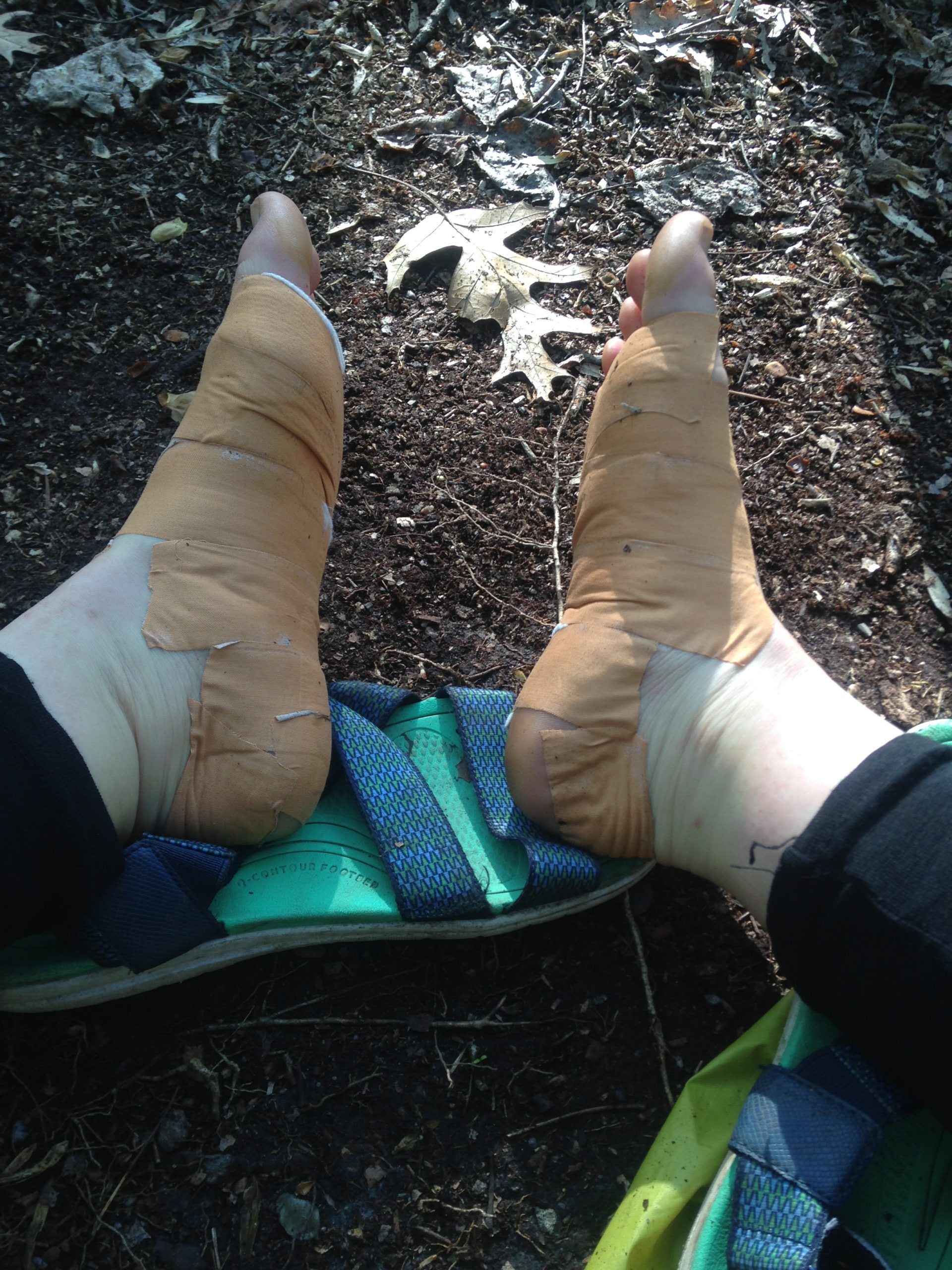THru-Hiking is an intensely personal experience that means something a bit different for everyone. There are no two equal excursions, and in reality there is no special ritual that you should spend to win the right to call yourself through a trip.
Anyway, there are some strangely specific and unifying experiences with which almost all hikers can relate to some level. Some are dumb and charming, others are … less, but all are par excellence of the long distance backpack.
With how many of these passage rites through the halls can be related?
1. Hunt your pants in the mountains
It would surprise you how many through hikers have shit at least once on the road. If you see someone who walks in their rain pants on a sunny day for no apparent reason, believe me, there is a reason.
Perhaps it is the intense exercise that is wreaking havoc with the intestinal microbioma or perhaps it is the large number of spam singles that most hikers eat daily (or hey, maybe it is Giardia!), But this is a surprisingly universal experience for hikers.
All I can tell you is to wear Imodium and don’t feel so bad about yourself if it happens.
This is a common experience, but certainly not totally ubiquitous, through experience. Here is an alternative that can find more identifiable (or be more willing to admit what you have experienced): accidentally in front of a traumatized group of day hiker because it did not realize the curves of the path to go to its carefully chosen Cathole place.
2. Share a hotel room with randomly 1-5 strangers that has just known that day
Jumping with bed with mysterious strangers that you met in the forest two hours ago is generally a non-no. But for hikers, it is an economical way to enjoy one night in the city.
The motels are expensive for a person, but if two or three hikers share a room, it can be the same price or cheaper than staying in a shelter, only with more peace and a private bathroom.
This is a small cheerful publication, but allow me to say here that common sense still applies to hikers, no matter how much we want to be dumb and dumb all the time. Do not do anything that bothers you just because «all hikers share hotel rooms.» Use your best judgment and listen to your instinct.
3. Emilling mega miles just to demonstrate that it can and immediately require a double zero to recover

I could walk 20 miles per day and advance 60 miles towards my goal in the course of three days. Or, listen to me, I could walk 57 miles in a day just to see if I can and then spend two horizontal days in a litera of shelter recovering.
There is no shadow in the last strategy. For many of us, through us it puts us in the best form of our lives, and I understand the impulse to push the limits a bit and see exactly how much our bodies are capable.
For those who appreciate the finest things in life (and have the budget to support it), there is also something to say to walk great miles and balance them with more time in the city. He knew many hikers who walked like this, mostly men who followed this or that important sporting event and, therefore, needed regular access to Trail Town sports bars, and everyone seemed happy enough.
Even so, if it is under pressure, remember that consistency often counts for more than the days of large miles. Walking 20 miles per day and taking fewer zeros could take it to your destination faster than using your body by deactivating the days of 35 miles that leave it in need of more rest.
Your mileage can vary with this advice; If your name is Heather Anderson, for example, you can ignore.
4. Experience existential fear about each pain and pain minors

Each hiker is obliged to get into the landfills sometimes after hitting the foot with the foot on a cunning rock or feeling a mysterious stubborn pain in the knee. In the photo above, I lost my head completely after experiencing persistent pain in my feet and compensated by completely locking both feet in gauze and leukotyy, which is certainly a) deranged, b) a terrible strategy yc) a waste of Leuko.
The hikers put much of themselves along the way (time, money, sweat, tears, hopes, dreams) and the idea that a strange meaningless accident that ends everything in a fraction of a second is frankly scary.
Imagine planning your walk for years and reaching a thousand miles along the path before a poorly placed step stops your life of a lifetime on your tracks. This kind of thing can happen, and we all live with a certain level of anxiety about the possibility of an injury that ends on walking. Therefore, every pain and minor pain can feel like an existential threat.
The best things you can do for yourself on the way is to stretch daily, stay hydrated, rest often, use good shoes and, in general, listen to your body.
A certain amount of pain is normal when it is through. It is a lot of wear in the body, after all. But pushing through extreme and persistent pain will only make an injury that ends the walk is more likely.
5. Experience an existential fear after realizing that you are eating the recommended amount of tuna 5 times

The single portion tuna packages are widely available in most groceries and service stations in the US. And look like an almost perfect hiking meal. They come in light packaging and add a blow of taste and additional proteins to their meals. As a result, they are a basic element in the food bag of many hikers.
But before all these great reasons to eat tuna, it is easy to forget that experts recommend limiting their tuna consumption only once a week, since the highest oceanic fish in the food chain contain a lot of mercury. Although they are convenient, it is probably better to say goodbye to the tuna packages if it trusted largely on them.
Tuna alternatives
Salmon packages are also quite common. Salmon contains mercury but in lower concentrations than tuna, so FDA recommends up to three portions per week.
Many grocery stores show chicken packages in the same area, which could be a great alternative.
I doubt in recommending spam singles as a healthier alternative to tuna because, well, you know. But if you are a carnivore in search of flavor pumps rich in protein and unique service, that is another option.
6. Hiking 1,500 miles and then call a transport service to go to 0.8 miles to the store
Well, first, zero days are destined to be rest days. The rest is good! We like to rest. There is no shame in saving so much energy for the real possible path.
And secondly, not all cities of trails are passable. Hiking on the shoulder of an occupied and narrow road with rapid traffic is not the safest plan.
Even half a mile can become an impassable distance if the store or restaurant you want to visit is on the opposite side of a six -lane road without an official pedestrian crossing.
One of the strange dualities through use is that you love the feeling of crossing great distances, but you deeply resort to the inconvenience of smaller trips on foot.
7. Eating the mysterious powder hiker box
Is serum protein? Mashed potatoes? Laundry soap? No one knows. But after examining enough experiences of hikers, your curiosity about the mysterious mysterious ubiquitous and without labeling is destined to overwhelm your common sense, especially if you are a hungry hiker with a budget.
Look, I can’t, in good awareness, recommend eating mysterious powders without label. But if your heart is determined to try, maybe only make the content sniff first and try to prepare a small sample in the city before adding everything to your food bag.
Who knows, maybe you will discover your new favorite path of paths. Surely I did it. (They were flakes of refused beans, if you are wondering).
8. Hiking for more than 1 hour in the wrong direction, crying
Generally this happens accidentally. But I knew one in Hiker who realized, 12 miles in his day, that he had left his Garmin Inreach in the shelter that morning. So he walked 12 miles back to recover it and camped in the same refuge that night, adding 24 miles to his legs, but did not end closer to Katahdin.
I love alpine beginnings when they are through, but the combination of low visibility and sleep deprivation makes it too easy to take a wrong twist early in the morning. The risk is higher when I have been camping a little out of the way. When I return to the rolling band, now I know that I have to be very careful to turn along the right path.
My worst conflict was in a prior ascent to Mount Washington. In the half light, I accidentally entered a social path where many hikers had reduced a change. When I rejoined AT, I accidentally turned the wrong path, without realizing that I had been briefly outside the road. I lead my classmates more than one mile back to Washington in the way we had appeared before realizing our (Mi) error.
Walking in the wrong way is a fun story after the fact, but it feels quite bad at the time, when you are tired and hungry and you just want to advance. Consume yourself in the knowledge that almost all hikers have done this at least once.
How many can be identified?
In no way do you have to experience everything, or even none, of the previous «rites» to call yourself. Like obtaining a path of path, these are simply experiences that many long -distance hikers share or can relate. How many have you experienced?
Graphic design by Zack Goldman




:max_bytes(150000):strip_icc():focal(749x0:751x2)/frida-breast-milk-ice-cream-1-080525-89ea1d5952294b31a1b791bd1d2b0e8e.jpg?w=238&resize=238,178&ssl=1)